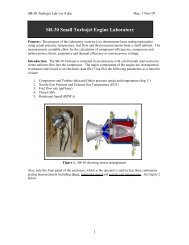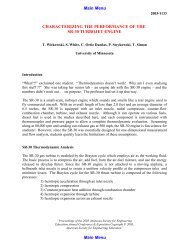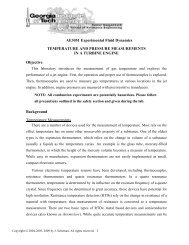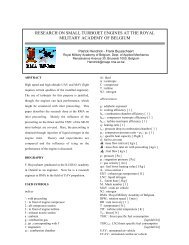Laboratory Systems Catalog - Turbine Technologies
Laboratory Systems Catalog - Turbine Technologies
Laboratory Systems Catalog - Turbine Technologies
Create successful ePaper yourself
Turn your PDF publications into a flip-book with our unique Google optimized e-Paper software.
MiniLab TM<br />
Gas <strong>Turbine</strong> Power System<br />
Description<br />
A complete gas turbine power plant designed for engineering, technical and military education as well as advanced research and study. The core<br />
gas-generator is representative of all major gas turbine types and permits ready textbook direct analysis of air equivalent Brayton and Gas<br />
<strong>Turbine</strong> cycles. Students are able to apply fluids, thermodynamic, combustion and gas turbine theory to the operation of an actual engine.<br />
<strong>Laboratory</strong> experience gained with the MiniLab is directly applicable to aero and marine turbine propulsion and industrial gas turbine applications.<br />
The SR-30 Turbo-Jet engine is designed and manufactured by <strong>Turbine</strong> <strong>Technologies</strong>, LTD specifically for the MiniLab Gas <strong>Turbine</strong> Power<br />
System. The compact engine features a centrifugal flow compressor, reverse flow annular combustor and an axial flow turbine stage. The SR-30<br />
follows the fundamental gas turbine cycle: Ambient air enters the engine through the bell shaped inlet. The air is then compressed, diffused and<br />
directed into the combustor can. Kerosene based fuel, introduced via six high-pressure atomization nozzles, is mixed with the compressed air<br />
and ignited. Heated combustion gas expands and accelerates through the vane guide ring causing the turbine to rotate. Useful work is extracted<br />
from this rotation as the turbine powers the compressor. The combustion gases are further accelerated through the thrust nozzle where the<br />
remaining heat energy is converted to kinetic energy in the form of jet thrust. The ejected gas returns to ambient atmospheric conditions thereby<br />
completing the thermodynamic cycle.<br />
For safety and performance reasons, no off-the-shelf, former military or surplus components are used in any portion of the engine. All components<br />
are manufactured in-house to exacting specifications. Electronic controlled vacuum investment casting insures void and impurity free components.<br />
Computer numerically controlled machine centers maximize finished part accuracy. Individual component materials are selected based upon<br />
desired mechanical properties, durability and longevity. Combustor components and the vane guide ring utilize Inconel® 718 alloy. The integral<br />
bladed disk turbine wheel is manufactured from CMR 247 Super Alloy. All material is fully traceable and verified to possess the desired properties<br />
specific to the application. The completed engine undergoes rigorous final operational testing and inspection. Purpose built from the start, the<br />
SR-30 requires no questionable modifications prior to integration into the MiniLab Gas <strong>Turbine</strong> Power System.<br />
The MiniLab cabinetry is composed of a rigid steel chassis mounted on rolling castors for portability and ease of storage, requiring no permanent<br />
facility modifications or additions. The SR-30 engine is securely mounted within the cabinet behind protective transparent polycarbonate shields<br />
affording the operator and observers clear, unimpeded viewing of the engine during operation. All engine accessories including fuel and oil<br />
pumps are located in the lower portion of the cabinet. No dedicated engine accessory drive is required, thereby eliminating the distraction of<br />
non-essential engine loading considerations in thermodynamic and performance analysis. Safe and reliable air starting provides for consistent<br />
and easy engine operation without the need for additional electric starters, complicated couplings, heavy cabling, high amperage current or<br />
auxiliary batteries. All fuel atomization is accomplished within the fuel control unit and adjacent nozzles. No gaseous fuels of any type are<br />
required for starting. A wide range of kerosene based or diesel blended fuels may be used without the need for any fuel preheating or conditioning.<br />
A single button initiates automatic engine start. System parameters are monitored during all phases of engine operation by an electronic<br />
engine control unit. Any out-of-limit condition results in the safe shutdown of the engine. Fuel and oil levels are monitored continuously<br />
thereby eliminating the potential for damaged pumps due to dry operation. Engine speed is fully controllable. A liquid crystal display panel<br />
alerts the operator to any system faults. Total run time and cycle counts are digitally recorded. A single button, prominently marked and readily<br />
located safely shuts the system down.<br />
Industrial grade sensors measure all key engine station parameters as<br />
well as overall system variables for real time display on the provided<br />
computer. Direct engine thrust is accurately measured through a<br />
pivoting bearing arrangement utilizing a calibrated load cell, eliminating<br />
problems inherent to linear bearings with critical alignment requirements.<br />
A USB connected digital data acquisition system is fully integrated and<br />
precalibrated. User configurable software allows the creation of custom<br />
data displays without the need for programming. Data can be recorded<br />
for playback or follow-on analysis. The full range of sensors allows<br />
calculations of fuel flow, thrust and pressure ratio to be compared<br />
directly to measured values.<br />
Design, technical and manufacturing information and specifications are<br />
available for specific teaching and research requirements. Actual engine<br />
components and system parts are optionally available for use as teaching<br />
and training aids. As the original engine manufacturer, complete spares<br />
availability is guaranteed. A free, two year warranty is provided on the<br />
entire MiniLab system including the SR-30 engine. Additional service<br />
and support is available as necessary. On site operator training is<br />
available at additional cost.<br />
A comprehensive Operator’s Manual details all aspects of system<br />
operation. Summary operating checklists allow rapid mastery of<br />
MiniLab Gas <strong>Turbine</strong> Power System operation. Safety instructions<br />
address all operating conditions.<br />
Gas <strong>Turbine</strong><br />
Power System<br />
CREATING EDUCATIONAL LABORATORY EQUIPMENT FOR TOMORROW’S ENGINEER<br />
Creating Educational <strong>Laboratory</strong> Equipment for Tomorrow’s Engineer | www.turbinetechnologies.com<br />
19









